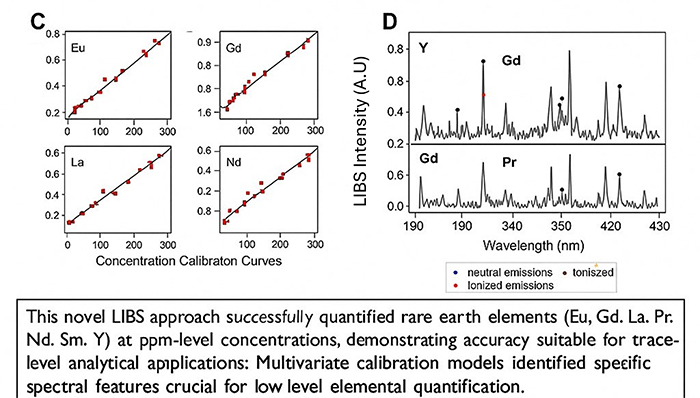Resources
 Part of the Oxford Instruments Group
Part of the Oxford Instruments Group
Expand
Collapse
 Part of the Oxford Instruments Group
Part of the Oxford Instruments Group
Rare Earth Elements (REEs), specifically europium (Eu), gadolinium (Gd), lanthanum (La), praseodymium (Pr), neodymium (Nd), samarium (Sm), and the transition metal yttrium (Y), represent indispensable materials within advanced technological systems pivotal for emerging energy solutions. These elements are integral to advancements in catalysis, magnetic materials, optoelectronics, and other technologies key to the global energy, healthcare, manufacturing, and defense industries. Precise analytical quantification of REEs at trace concentration levels, typically in the parts per million (ppm) range, is essential for diverse industrial and environmental applications, including the recycling of electronic waste, nuclear fuel reprocessing, and nuclear forensic analysis. Such analytical capabilities are critical to progress and innovation that are inherently aligned with global sustainability initiatives and the international imperative to achieve Net Zero emissions.
While conventional analytical techniques such as inductively coupled plasma mass spectrometry (ICP-MS) and inductively coupled plasma optical emission spectroscopy (ICP-OES) provide reliable and precise measurements, these methodologies are characterized by extensive sample preparation requirements, lengthy analytical cycles, and substantial operational costs. Additionally, these methods can be logistically challenging and impractical for real-time, in-situ measurements required in industrial settings, especially when dealing with hazardous or radioactive materials.
In response to these limitations, Laser-Induced Breakdown Spectroscopy (LIBS), integrated with advanced optical detection technologies such as the Andor iStar intensified CCD (ICCD), offers a sophisticated, efficient alternative capable of rapid, non-destructive, and high-sensitivity elemental analysis. LIBS is particularly suited for challenging industrial and environmental contexts, providing enhanced adaptability for high-throughput, real-time analysis [1,2].
LIBS operates by focusing a pulsed, high-energy laser beam onto a target material, creating a transient plasma composed of electronically excited atomic and ionic species. The subsequent emission of characteristic photons as these species revert to lower-energy states provides distinctive spectral signatures that can be captured and quantitatively analyzed. In this study, the LIBS experimental configuration employed a 532 nm Q-switched laser (Big Sky CFR-Ultra), precisely calibrated to deliver consistent pulse energies of 45 mJ. The emitted optical signatures were analyzed using a Catalina Scientific SE 200 Echelle spectrometer coupled with an Andor iStar ICCD detector (DH334T), achieving high-resolution spectral acquisition (0.06 nm resolution) across an extensive wavelength range of 190–800 nm (Figure 1).

Figure 1: Experimental setup with a XYZ sampling stage and ANDOR ICCD detector. The spectra are shown for the elements of interest.
Sample preparation involved embedding precisely weighed oxide forms of Eu, Gd, La, Pr, Nd, Sm, and Y within graphite pellets. The REE concentrations ranged systematically from 10 ppm to 300 ppm, and each concentration level underwent five independent replicate measurements. This rigorous replication ensured statistical reliability, reproducibility, and robustness of subsequent multivariate calibration analyses.
Spectral analysis via LIBS revealed distinct emission lines specific to each REE, predominantly situated within a spectral window spanning 350–450 nm, with maximal discriminatory power identified in the region between 390–430 nm. Advanced multivariate statistical techniques, specifically Partial Least Squares regression (PLS), facilitated the development of robust calibration models for precise elemental quantification at low ppm concentrations.
Model validation demonstrated strong predictive performance for REEs including Eu, Gd, Pr, Nd, and Y, characterized by excellent coefficients of determination (R² values ranging from 0.890 to 0.933). Conversely, La and Sm exhibited slightly reduced predictive accuracy (R² values ranging from 0.730 to 0.839), indicative of more complex matrix interactions and emphasizing the necessity for meticulous matrix-specific calibration.

The analytical precision was further enhanced through detailed analysis of the PLS regression coefficients, which enabled definitive identification of critical spectral features associated with each element. This targeted approach effectively simplified the inherently complex LIBS spectra, facilitating accurate trace-level detection and enhancing the analytical fidelity of the technique. Additionally, the investigation underscored the critical importance of accounting for matrix variability, reinforcing the necessity for rigorous, matrix-specific calibration protocols.
The outcomes of this research emphasize the substantial potential of LIBS, particularly when integrated with high-sensitivity detection platforms such as the Andor iStar ICCD, for rapid and accurate on-site quantification of REEs at trace concentrations. This capability is instrumental for numerous practical applications in renewable energy technologies, nuclear security protocols, and environmental conservation efforts.
LIBS substantially streamlines the analytical procedure, significantly reduces analysis duration compared to traditional methods, and provides an effective toolset for routine, large-scale industrial and environmental monitoring tasks. Given the increasing global reliance on REEs and their critical role in emerging technologies, LIBS has become a pivotal analytical method for efficient resource management, optimization of recycling operations, and rigorous monitoring of environmental waste streams, directly supporting global sustainability objectives and Net Zero emissions targets.
In conclusion, LIBS technology demonstrates not only the necessary sensitivity for ppm-level quantification but also aligns seamlessly with broader analytical demands for enhanced efficiency, precision, and versatility, rendering it an essential analytical methodology within sustainable and innovative environmental, nuclear energy, and mining applications research.
[1] Madhavi Martin, Daniel Hamm, Samir Martin, Steve Allman, Gary Bell, Rodger Martin, “Micro-Laser-Induced Breakdown Spectroscopy: A Novel Approach Used in the Detection of Six Rare Earths and One Transition Metal,” Minerals, 9(2), 103 (2019). https://doi.org/10.3390/min9020103 (registering DOI).
[2] Madhavi Martin, Rodger C. Martin, Hunter B. Andrews, Steve Allman, Deanne Brice, Samir Martin, and Andre Nicolas. “Quantification of Rare-Earths in the parts-per-million range- A Novel Approach in the Application of Laser-Induced Breakdown Spectroscopy”. Appl. Spectrosc. Vol 76 (8) 2022 https://doi.org/10.1177/00037028221092051 (2022).
Date: May 2025
Author: Miguel Rodriguez Jr., Madhavi Martin
Category: Application Note
